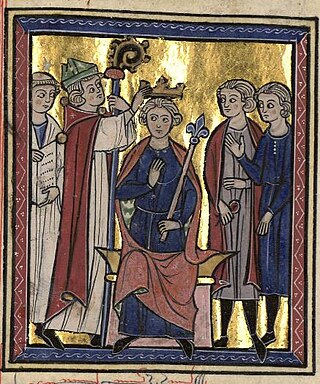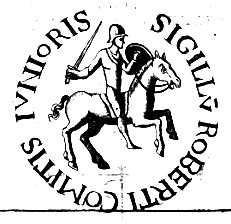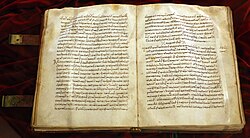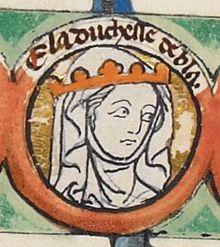
Fulk, also known as Fulk the Younger, was the count of Anjou from 1109 to 1129 and the king of Jerusalem with his wife Melisende from 1131 to his death. During their reign, the Kingdom of Jerusalem reached its largest territorial extent.

Robert II, Count of Flanders was Count of Flanders from 1093 to 1111. He became known as Robert of Jerusalem or Robert the Crusader after his exploits in the First Crusade.
Baldwin II (1056–1098?) was count of Hainaut from 1071 to his death. He was an unsuccessful claimant to the County of Flanders. He disappeared in Anatolia during the First Crusade.

Barisan of Ibelin was an important figure in the crusader Kingdom of Jerusalem, and was the founder of the Ibelin family. His name was later written as "Balian" and he is sometimes known as Balian the Elder, Barisan the Old or Balian I. Barisan was lord of Ramla from 1138 to 1150.
Morphia of Melitene was the queen consort of the crusader Kingdom of Jerusalem from 1118 until her death. She was an Armenian by ethnicity and an adherent of the Greek Orthodox faith. Her father, Gabriel, was a warlord in northern Syria. He wished to marry her off to one of the crusade leaders who were carving out states in the Levant, and eventually chose Count Baldwin II of Edessa. They married around 1100 and had four daughters: Melisende, Alice, Hodierna, and Ioveta. In 1118, Baldwin was elected king of Jerusalem; the next year, Morphia became the first woman to be crowned queen of Jerusalem. She did not participate in the government but took initiative to liberate her husband after he was captured in 1123. She died a few years later. According to historian Bernard Hamilton, her religious practices left a lasting mark on the status of Orthodox Christians in the crusader kingdom.
Hugh II was the count of St. Pol in Artois, after having succeeded his brother Guy I who died without issue. He was the son of Hugh I. He participated in the First Crusade (1096–99) with his son Enguerrand, where they both won fame as military leaders. Being vassals of Eustace III of Boulogne, they probably travelled east in his company, among the retinue of Godfrey of Bouillon.

Constance of France was Countess of Troyes from her first marriage and Princess of Antioch from her second marriage. She was regent during the minority of her son. Constance was the eldest of five children and was the only daughter from her father's first marriage. Her brother was Louis VI of France.
William of Bures was Prince of Galilee from 1119 or 1120 to his death. He was descended from a French noble family which held estates near Paris. William and his brother, Godfrey, were listed among the chief vassals of Joscelin of Courtenay, Prince of Galilee, when their presence in the Holy Land was first recorded in 1115. After Joscelin received the County of Edessa from Baldwin II of Jerusalem in 1119, the king granted the Principality of Galilee to William. He succeeded Eustace Grenier as constable and bailiff in 1123. In his latter capacity, he administered the kingdom during the Baldwin II's captivity for more than a year, but his authority was limited.
Ida, Countess of Hainaut , daughter of Henry II, Count of Louvain, and Adela of Thuringa. Ida was sister to Godfrey I, Count of Louvain.
The Houses of Montlhéry and Le Puiset is the name given by two powerful families, joined in marriage, that played a major role in the 11th and 12th centuries in both the Crusades as well as the administration of the Holy Land. The Montlhéry branch consists of the relatives of Guy I of Montlhéry and Hodierna of Gometz. The Le Puiset branch consists of the descendants of Everard I of Breteuil. Everard’s son Hugh I of Le Puiset married Guy’s daughter Alice, bringing the families together. Prominent members of the families are as follows.
Cecilia of Le Bourcq was a Cilician fiefholder as lady of Tarsus. She was the daughter of Count Hugh I of Rethel and Melisende, daughter of Guy I of Montlhéry. Cecilia's brother was Baldwin II of Jerusalem.
Renaud II of Clermont was son of Hugh I, Count of Clermont-en-Beauvaisis and Marguerite de Roucy. Renaud became Count of Clermont-en-Beauvaisis upon his father's death in 1101.
The army of Hugh the Great was formed after the Council of Clermont, led by Pope Urban II in November 1095. Hugh, son of Henry I of France, and his wife Anne of Kiev, was Count of Vermandois, de jure uxoris, due to his marriage to Adelaide of Vermandois. In August 1096, Hugh and his small army left France in prima profectione, the first army of the third wave to leave France, and travelled to Bari, Italy, and then crossed the Adriatic Sea to the Byzantine Empire, in an armada commanded by Arnout II, Count of Aarschot. When Hugh entered Constantinople, he carried a Vexillum sancti Petri, a banner given to him by the pope, Hugh being the last such noble to carry the banner.
The army of Godfrey of Bouillon, the duke of Lower Lorraine, in response to the call by Pope Urban II to both liberate Jerusalem from Muslim forces and protect the Byzantine Empire from similar attacks. Godfrey and his army, one of several Frankish forces deployed during the First Crusade, was among the first to arrive in Constantinople. The army was unique in that it included among its warriors the first three kings of Jerusalem, although Godfrey preferred the title Defender of the Holy Sepulchre, Advocatus Sancti Sepulchri, as he believed that the true King of Jerusalem was Christ. This article focuses on the members of the army rather that its exploits which are described in detail in Godfrey’s biography as well as numerous sources listed below.
The army of Raymond of Saint-Gilles was one of the first to be formed after Pope Urban II called for the First Crusade. Raymond formed a Provençal army and left his County of Toulouse in October 1096, traveling over the land route. He was the only leader of a major army that did not swear an oath of fealty to Byzantine emperor Alexius I Komnenos.
The armies of Bohemond of Taranto, formed in 1097, include a major component of the First Crusade. He is regarded as the real leader of the First Crusade. He formed a second army in 1107 to defend Antioch but instead used it to attack the Byzantine emperor Alexios I Komnenos, resulting in the Treaty of Devol, codifying Bohemond’s defeat. Runciman estimates that the first army included 500 cavalry and 3500 infantrymen and other estimates that the second army was at 34,000 personnel strength are likely greatly exaggerated.
Robert II of Flanders' army was formed shortly after that of his kinsman Godfrey of Bouillon, arriving in Constantinople considerably later. His wife Clementia of Burgundy was regent of Flanders in his absence. The known members of the army, mostly Flemish, included the ones listed below, as reported in histories of the First Crusade. Unless otherwise noted, references are to the on-line database of Riley-Smith, et al., and the hyperlinks therein provide details including original sources. The names below are also referenced in the Riley-Smith tome, Appendix I: Preliminary List of Crusaders. Those references are not shown unless they appear elsewhere in the text of the book. Articles that are hyperlinked to a more detailed article in this encyclopædia rely on the latter for references.
The army of Robert Curthose, Duke of Normandy, left for the Holy Land on the First Crusade. Robert was the eldest son of William the Conqueror and brother to William Rufus, king of England. He was reportedly so poor that he often had to stay in bed for lack of clothes. In order to raise money for the crusade he mortgaged his duchy to his brother William II of England. His army joined the contingent of Robert II, Count of Flanders, and Stephen, Count of Blois.
The armies of Count Stephen of Blois participated in both the First Crusade of 1096 and the Crusade of 1101. Stephen apparently fled the battlefield at the Siege of Antioch and returned home. He was coerced by his wife, Adela of Normandy, to form another army to return to the Holy Land in 1101, accompanied by Count Stephen I of Burgundy.
The following is an overview of the armies of First Crusade, including the armies of the European noblemen of the "Princes' Crusade", the Byzantine army, a number of Independent crusaders as well as the People's Crusade and the subsequent Crusade of 1101 and other European campaigns prior to the Second Crusade beginning in 1147.










